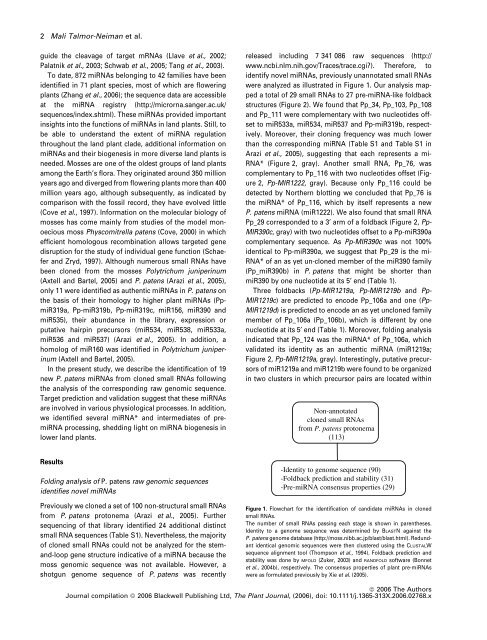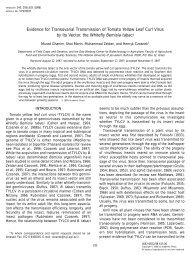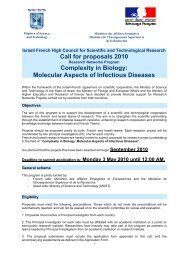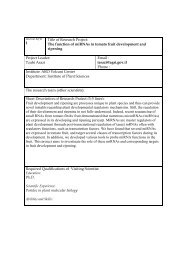Novel micro-RNAs and intermediates of micro-RNA biogenesis from ...
Novel micro-RNAs and intermediates of micro-RNA biogenesis from ...
Novel micro-RNAs and intermediates of micro-RNA biogenesis from ...
You also want an ePaper? Increase the reach of your titles
YUMPU automatically turns print PDFs into web optimized ePapers that Google loves.
2 Mali Talmor-Neiman et al.guide the cleavage <strong>of</strong> target m<strong><strong>RNA</strong>s</strong> (Llave et al., 2002;Palatnik et al., 2003; Schwab et al., 2005; Tang et al., 2003).To date, 872 mi<strong><strong>RNA</strong>s</strong> belonging to 42 families have beenidentified in 71 plant species, most <strong>of</strong> which are floweringplants (Zhang et al., 2006); the sequence data are accessibleat the mi<strong>RNA</strong> registry (http://<strong>micro</strong>rna.sanger.ac.uk/sequences/index.shtml). These mi<strong><strong>RNA</strong>s</strong> provided importantinsights into the functions <strong>of</strong> mi<strong><strong>RNA</strong>s</strong> in l<strong>and</strong> plants. Still, tobe able to underst<strong>and</strong> the extent <strong>of</strong> mi<strong>RNA</strong> regulationthroughout the l<strong>and</strong> plant clade, additional information onmi<strong><strong>RNA</strong>s</strong> <strong>and</strong> their <strong>biogenesis</strong> in more diverse l<strong>and</strong> plants isneeded. Mosses are one <strong>of</strong> the oldest groups <strong>of</strong> l<strong>and</strong> plantsamong the Earth’s flora. They originated around 350 millionyears ago <strong>and</strong> diverged <strong>from</strong> flowering plants more than 400million years ago, although subsequently, as indicated bycomparison with the fossil record, they have evolved little(Cove et al., 1997). Information on the molecular biology <strong>of</strong>mosses has come mainly <strong>from</strong> studies <strong>of</strong> the model monoeciousmoss Physcomitrella patens (Cove, 2000) in whichefficient homologous recombination allows targeted genedisruption for the study <strong>of</strong> individual gene function (Schaefer<strong>and</strong> Zryd, 1997). Although numerous small <strong><strong>RNA</strong>s</strong> havebeen cloned <strong>from</strong> the mosses Polytrichum juniperinum(Axtell <strong>and</strong> Bartel, 2005) <strong>and</strong> P. patens (Arazi et al., 2005),only 11 were identified as authentic mi<strong><strong>RNA</strong>s</strong> in P. patens onthe basis <strong>of</strong> their homology to higher plant mi<strong><strong>RNA</strong>s</strong> (PpmiR319a,Pp-miR319b, Pp-miR319c, miR156, miR390 <strong>and</strong>miR535), their abundance in the library, expression orputative hairpin precursors (miR534, miR538, miR533a,miR536 <strong>and</strong> miR537) (Arazi et al., 2005). In addition, ahomolog <strong>of</strong> miR160 was identified in Polytrichum juniperinum(Axtell <strong>and</strong> Bartel, 2005).In the present study, we describe the identification <strong>of</strong> 19new P. patens mi<strong><strong>RNA</strong>s</strong> <strong>from</strong> cloned small <strong><strong>RNA</strong>s</strong> followingthe analysis <strong>of</strong> the corresponding raw genomic sequence.Target prediction <strong>and</strong> validation suggest that these mi<strong><strong>RNA</strong>s</strong>are involved in various physiological processes. In addition,we identified several mi<strong>RNA</strong>* <strong>and</strong> <strong>intermediates</strong> <strong>of</strong> premi<strong>RNA</strong>processing, shedding light on mi<strong>RNA</strong> <strong>biogenesis</strong> inlower l<strong>and</strong> plants.released including 7 341 086 raw sequences (http://www.ncbi.nlm.nih.gov/Traces/trace.cgi?). Therefore, toidentify novel mi<strong><strong>RNA</strong>s</strong>, previously unannotated small <strong><strong>RNA</strong>s</strong>were analyzed as illustrated in Figure 1. Our analysis mappeda total <strong>of</strong> 29 small <strong><strong>RNA</strong>s</strong> to 27 pre-mi<strong>RNA</strong>-like foldbackstructures (Figure 2). We found that Pp_34, Pp_103, Pp_108<strong>and</strong> Pp_111 were complementary with two nucleotides <strong>of</strong>fsetto miR533a, miR534, miR537 <strong>and</strong> Pp-miR319b, respectively.Moreover, their cloning frequency was much lowerthan the corresponding mi<strong>RNA</strong> (Table S1 <strong>and</strong> Table S1 inArazi et al., 2005), suggesting that each represents a mi-<strong>RNA</strong>* (Figure 2, gray). Another small <strong>RNA</strong>, Pp_76, wascomplementary to Pp_116 with two nucleotides <strong>of</strong>fset (Figure2, Pp-MIR1222, gray). Because only Pp_116 could bedetected by Northern blotting we concluded that Pp_76 isthe mi<strong>RNA</strong>* <strong>of</strong> Pp_116, which by itself represents a newP. patens mi<strong>RNA</strong> (miR1222). We also found that small <strong>RNA</strong>Pp_29 corresponded to a 3¢ arm <strong>of</strong> a foldback (Figure 2, Pp-MIR390c, gray) with two nucleotides <strong>of</strong>fset to a Pp-miR390acomplementary sequence. As Pp-MIR390c was not 100%identical to Pp-miR390a, we suggest that Pp_29 is the mi-<strong>RNA</strong>* <strong>of</strong> an as yet un-cloned member <strong>of</strong> the miR390 family(Pp_miR390b) in P. patens that might be shorter thanmiR390 by one nucleotide at its 5¢ end (Table 1).Three foldbacks (Pp-MIR1219a, Pp-MIR1219b <strong>and</strong> Pp-MIR1219c) are predicted to encode Pp_106a <strong>and</strong> one (Pp-MIR1219d) is predicted to encode an as yet uncloned familymember <strong>of</strong> Pp_106a (Pp_106b), which is different by onenucleotide at its 5¢ end (Table 1). Moreover, folding analysisindicated that Pp_124 was the mi<strong>RNA</strong>* <strong>of</strong> Pp_106a, whichvalidated its identity as an authentic mi<strong>RNA</strong> (miR1219a;Figure 2, Pp-MIR1219a, gray). Interestingly, putative precursors<strong>of</strong> miR1219a <strong>and</strong> miR1219b were found to be organizedin two clusters in which precursor pairs are located withinNon-annotatedcloned small <strong><strong>RNA</strong>s</strong><strong>from</strong> P. patens protonema(113)ResultsFolding analysis <strong>of</strong> P. patens raw genomic sequencesidentifies novel mi<strong><strong>RNA</strong>s</strong>Previously we cloned a set <strong>of</strong> 100 non-structural small <strong><strong>RNA</strong>s</strong><strong>from</strong> P. patens protonema (Arazi et al., 2005). Furthersequencing <strong>of</strong> that library identified 24 additional distinctsmall <strong>RNA</strong> sequences (Table S1). Nevertheless, the majority<strong>of</strong> cloned small <strong><strong>RNA</strong>s</strong> could not be analyzed for the stem<strong>and</strong>-loopgene structure indicative <strong>of</strong> a mi<strong>RNA</strong> because themoss genomic sequence was not available. However, ashotgun genome sequence <strong>of</strong> P. patens was recently-Identity to genome sequence (90)-Foldback prediction <strong>and</strong> stability (31)-Pre-mi<strong>RNA</strong> consensus properties (29)Figure 1. Flowchart for the identification <strong>of</strong> c<strong>and</strong>idate mi<strong><strong>RNA</strong>s</strong> in clonedsmall <strong><strong>RNA</strong>s</strong>.The number <strong>of</strong> small <strong><strong>RNA</strong>s</strong> passing each stage is shown in parentheses.Identity to a genome sequence was determined by BLASTN against theP. patens genome database (http://moss.nibb.ac.jp/blast/blast.html). Redundantidentical genomic sequences were then clustered using the CLUSTALWsequence alignment tool (Thompson et al., 1994). Foldback prediction <strong>and</strong>stability was done by MFOLD (Zuker, 2003) <strong>and</strong> RANDFOLD s<strong>of</strong>tware (Bonnetet al., 2004b), respectively. The consensus properties <strong>of</strong> plant pre-mi<strong><strong>RNA</strong>s</strong>were as formulated previously by Xie et al. (2005).ª 2006 The AuthorsJournal compilation ª 2006 Blackwell Publishing Ltd, The Plant Journal, (2006), doi: 10.1111/j.1365-313X.2006.02768.x
















